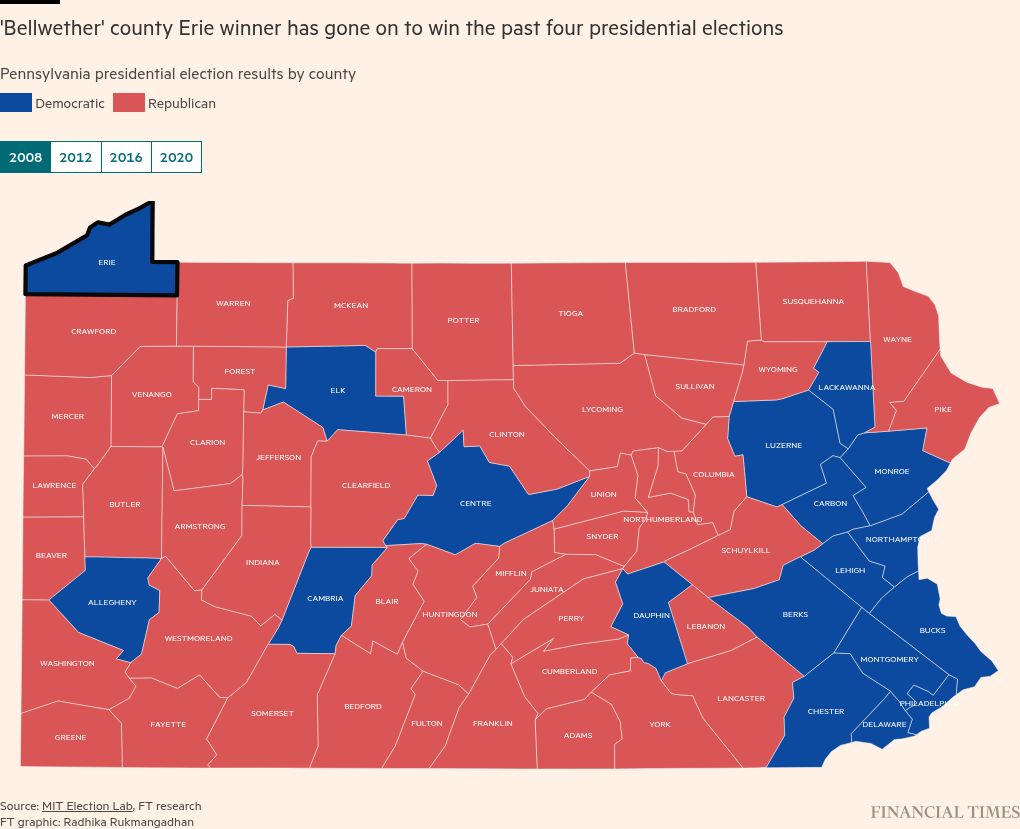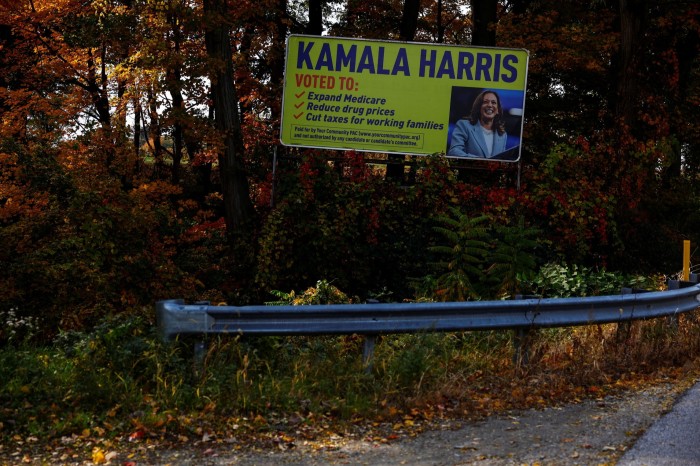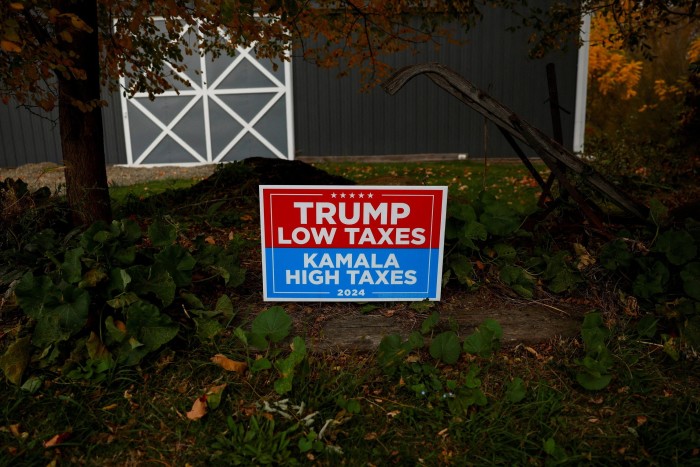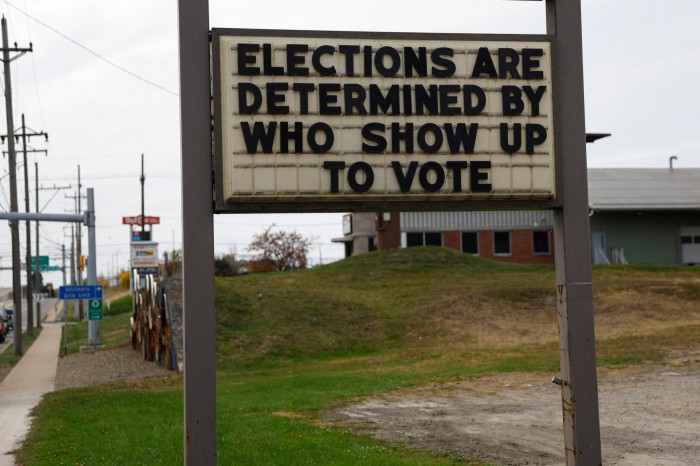
“I definitely do see a lot fewer Trump signs here than I did in 2020,” said Brandon DiMarco, a life-long resident of Erie, Pennsylvania, on a parkway overlooking the blue expanse of Lake Erie.
DiMarco, who works two jobs and is studying to become a financial adviser, voted for Donald Trump in 2020, and had initially planned to vote for Robert F Kennedy Jr in next week’s US presidential election. But now he is backing Kamala Harris because of her economic policies, and sees evidence that others are doing the same.
“I see more people in Erie flip-flopping towards going from Republican to Democrat than I do vice versa. I don’t think it’s drastic, but I definitely see some more people shifting their political outlook towards that,” he said.
In one of the tightest White House races in modern history, Pennsylvania is the contest’s biggest prize. The fight there is fierce — and expensive. Harris and Trump have poured hundreds of millions of dollars into the state and visited it more than any other battleground.
In this most critical swing state, Erie county is ground zero. Recent elections suggest winning here wins the presidency; the county has voted for the eventual winner in every election since 2008, including when Joe Biden defeated Trump in Erie by just 1,300 votes.
With polling showing Trump and Harris in a virtual dead heat in the country and other swing states, a few votes in Erie could decide the next president.

Last Saturday, Erie hosted Trump’s running mate, JD Vance, and Bernie Sanders, the progressive senator from Vermont, who was campaigning on behalf of the Democrats. Harris’s running mate Tim Walz held a campaign event there on Thursday.
“It’s always close, but I’m worried we are getting a little overconfident in Pennsylvania,” said Vance, as he implored supporters at his rally to get their families and friends to vote for Trump.
Both parties are on the ground in force.
After limited canvassing in 2020 because of Covid-19, energised Democrats see revived organising efforts as their path to victory in the county.
“We are cautiously optimistic,” said Sam Talarico, chair of the Erie Democratic party. “With the polls being as close as they are, the only barometer you have is what you see on the ground, and the interest and enthusiasm [for Harris in Erie] is off the charts.”


Republicans in the county are also better organised than four years ago, and are leaning heavily on outside groups, such as Turning Point USA and Early Voter Action, which are funded by Trump-supporting political action committees.
The local party’s canvassing efforts also have had “more energy” than in 2020, said John Guyton, a Republican volunteer. “We’ve got the spirit. We’ve got the energy. We’ve got the drive. People are fired up about participating,” he said.
For Harris to win Pennsylvania, it will not be enough to carry Erie. She will have to chip away at Trump’s wide margins in the more rural counties stretching south from Erie to Pittsburgh, while increasing her numbers in Democratic strongholds such as Philadelphia and its suburbs.
In 2020, when Biden won the state by just over 80,000 votes, he picked up 22,000 more than Hillary Clinton did across Beaver, Butler, Crawford, Lawrence, Mercer, and Venango counties, where Trump gained 31,000 from 2016.
The red brick streets of Butler, the conservative stronghold north of Pittsburgh where Trump was shot this July, were filled with red Trump signs in 2020.
But there are noticeably fewer this year and many houses are advertising their support for Republican down-ballot candidates rather than for the presidency.
“There were so many [Trump signs] last time, but there are not as many this time,” said Jessica Ireland, a resident of Butler who is planning to vote for Harris.
“I think everyone is just tired [of Trump]. He has come to Butler twice, and almost got killed here once,” said Tabatha Switzer, Ireland’s neighbour, who is not planning to vote.
The Democrats now have campaign offices across the region, unlike in 2020, when they had limited canvassing operations in Republican strongholds
“We are pretty positive, but doubt creeps in,” said Catherine LaLonde, chair of the Butler County Democratic Committee, who is helping to run a presidential canvassing operation for the first time this cycle.
Further south in Aliquippa, an industrial town in Beaver county with a large Black population, some voters see waning enthusiasm for the Republican candidate.
“There is less enthusiasm [for Trump]. But there is also less enthusiasm all around,” said Denise Cage, an undecided voter, as she sat outside the laundromat on Aliquippa’s main thoroughfare. “There are Trump signs everywhere in Beaver, but there have always been. But I’ve been seeing a lot more of the Harris signs.”

But Bill Derrick, an employee of a local contracting company who did not vote for Clinton but voted for Biden in 2020 and is supporting Harris, is worried the unusual nature of this year’s campaign means it will be harder for Democrats to maintain Biden’s margins in Beaver.
Derrick said: “Trump has his base, and they are voting for him no matter what, especially after the assassination attempt. I think because Kamala Harris came in late, there are a lot of people out there who will say they are not as inspired by her.”
Back in Erie many say the vote feels too close to call.
“I feel like it’s leaning either way at the moment,” said Katelyn Peters, who works at a restaurant in the food hall right off the city’s main square and who said she did not know who she would vote for.
Bill Ohmer, an accountant and registered Republican, who is planning to vote for Trump, said: “It’s very close. Erie is just one of those places where you just don’t know.”
Additional reporting by Radhika Rukhmangadhan